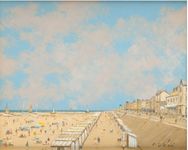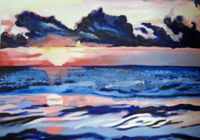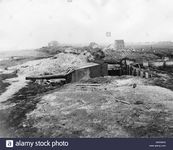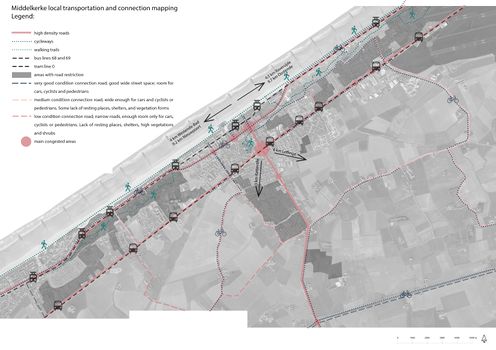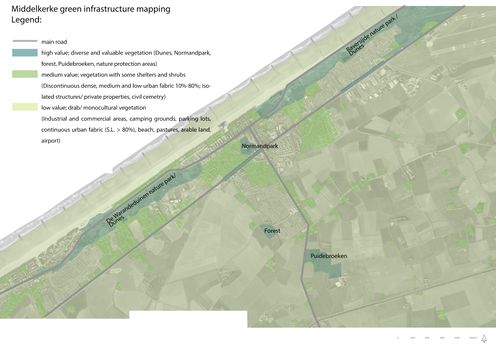COLAND Case Study 2020 - Middelkerke
>>>back to working groups overview
Rationale
- Why do you think this case is relevant? What is your hypothesis considering the landscape challenges?
This case is relevant because it is a seasonal tourist attraction and it has three strongly distinctive landscape patterns- semi-natural wide coastline, and artificial urban and agricultural patterns, which are affected because of people. Artificiality and existence of man brings out challenges in biodiversity, soils, water, and marine environment. The coast is most sensitive to floods, erosion, and eutrophication.
Location and scope
You can edit this map with the map editor
A Landscape System Analysis
A.1 Landscape layers and their system context
Geomorphology, landscape units and coastal typology
- The terrain forming the coat of Belgium dates back from the Holocene epoch (1.7 thousand years ago) from the Quaternary era. Due to the old age of the geological foundation and the proximity to the North Sea, most of the terrain is now underwater.
This problem was handled by the Belgium state by creating new arificial areas.
Land use
In Middelkerke the most dominant land use structures are agricultural land, urban fabrics, dunes on East and West side of the sub-municipality, and closed camping grounds around the town. In the case of increasing the urban structure, there is a possibility for agricultural land to decrease. Driving forces are tourism growth and changes in local structure. For example if there are enough possibilities for people to live there permanently (job, education facilities, etc), then probably the urban structure will decrease. The most likely and fastest changes will occur in agricultural land. Because of the urban structure increase and human hand, the dunes near the coast could be in danger.
Green/blue infrastructure
What are the major potential elements of a green/blue infrastructure network? Are these likely to change/disappear? Why is that?
- Green area
- Blue area
- Natural area
- Normandpark
- Agricultural field
- Vijver Normandpark
One of the most dominant green/blue infrastructures at Middlekerke can be found along the coastline. The Middlekerke s beach line is the longest in Belgium. It contains sand beaches. Residents and tourists can experience nature in this way. There are a Hiking trail from Middelkerke-Westende and Statues of cartoon characters and Cinema on the beach. It may affect the infrastructures of this green and blue and it might damage the nature. Tides and storms can affect also. Normandpark is A green infrastructure in the center of Middelkerke. It is located near the beach. The pond of Normandpark was redone in a sustainable way. This area is really comfortable for enjoying the nature in the center of Middlekerke.In addition, there are lots of agricultural fields that can be considered as green infrastructure.Most of the agricultural field in Belgium is divided between barley, corn, wheat, potatoes, and vegetables and fruits and there are some areas for breeding animals.
Actors and stakeholders
- Draw a stakeholder and/or power map: Who is affected highly but with low power? Who has high power but is not affected?
- The main actors are the Middelkerke Municipality and the West Flanders Authorities, but also the bussiness owners, the investors, the community and tourist. Each of these aactors and stakeholders have a higher or lower impact on the changes that affect Middelkerke and a higher or lower interest in what happens to the city.
Sacred spaces and heritage
Which places/elements hold cultural value and to whom?
Built environment
Middelkerke is rich by its architectural heritage. Beautiful street views have characterized the town from the 19th century. Although the town has modernized you can see the hints of the city's historic architectural value through the Townhall, Traction station, Saint Theresa Chapel and through hotels, villas and even garage. The second most important value of the place is the train connection between Knokke and De Panne. That's the reason why seaside tourism in the area has been popular since World War I. These values are important to the citizens and tourists by its beauty and formed network.
Middelkerke Town Hall in Spermaliestraat 1. Protected building since June of 2002 in the Middelkerke Submunicipality. The eclectic Town Hall was built in 1924-1925 and is designed by architect G. Van Damme. [1]
The Coast Tram, the longest tram line in the world, is a public transport service between Knokke and De Panne [2]. In Middelkerke there are two architectural heritage buildings in Leopldlaan street honoring the original tramline- the Tram booth [3] and Traction station. The Traction station (on the picture) is built in the early 1920s and is designed by architect Georges Vivenoy. On the facade, there can be seen an art deco impact. Traction station has been protected as a monument since October of 1995.[4]
Art Nouveau style chapel of Saint Theresa is a protected building since June of 2002. The modernist north-south oriented chapel was founded in 1932-1933 and is designed by architect AV Flaubert. In the interior, there are numerous neoclassical elements, frescos and stained glass windows making the chapel an important sight to see. [5][6]
Middelkerke is rich by its architectural heritage. There are numerous protected buildings in the style of art deco and eclectic, built in the 1920s. On the picture is an example of eclectic Hotel Continental on the Joseph Casselaan 3, Zeedijk 59. It is situated in the promenade and has a view to the sea from Zeedijk street [7]. Few of them are the style of neo-gothic and neo-Rococo, which are built around 1889-1899. [8]
Natural environment
In Middelkerke there are three most important nature reserves- Warandeduinen, Puidebroeken, and Raversyde nature park. If Puidebroeken is important for birds, frogs, insects, and plants then Warandeduinen and Raversyde hold extra value for people's health and to the environment.
The Warandeduinen nature park is a certified nature reserve since 2003. The area size is 33 hectares big. [9]. This is a calcareous dune belt with a large and varied natural richness between Westende-Bad and Middelkerke. The area is rich by the growth of orchids [10]. Watch more photos in link: [11].
The Puidebroeken (in English: Puffy Trousers) is a 14.5 hectares big nature reserve near Middelkerke. It is a protected area since 2003. [12]. The area contains mainly artificial grounds from World War I when it was used to excavate clay for the production of brick. For now it a wet meadow that has a bad water runoff. There are living numerous meadow birds, frogs, insects, and plants. The area is not freely accessible. [13]
Raversyde Nature Park is a large landscape of water, reed fields, grasslands, meadows, plantations, and forests. It is situated in Ostend but is close to our case study Middelkerke. [14]
Symbols of Middelkerke, artefacts
In between the coast of Middelkerke to Westende-Bad there are 15 bronze statues of cartoon characters and also five Beaufort monuments such as two horns (I Can Hear It) and excavator (Caterpillar 5bis), etc. These sculptures add symbolic meaning to Middelkerke's coast and town, and invites visitors to see them.
Visual appearance and landscape narrative
- Which elements are essential for the landscape character?
In Middelkerke, the coast and the sea play a central role. It contains sand beaches of about nine kilometers long which are connected by a boulevard and have characteristic features with its urban area and agricultural land behind. [17] [18]
- Has the landscape been painted or otherwise depicted, when and whom? Which elements are essential?
Many painters illustrated the interesting coastal landscape the colorful sea, and the nice urban view. Pierre Stefani (France, born 1938) depicted where people are enjoying in the summertime and where beach shows low sea tide. Claude Hardenne (France- 1946) depicted the colorful sea at the age of 16. [19][20]
- Which narratives exist? Who has written about this landscape or depicted it in some way?
The story of Middelkerke: Middelkerke seaside town equipped with Hotels, apartments, villas, cafes, restaurants, and beaches, as well as situated in dunes and polders. The polders perfectly suit for walks or bike and skeeters tour through an overwhelming landscape. Beach facilities and public facilities like tram are also located within the coastal area. [21] The first reference of Middelkerke is found in 1218. Before 1867 it mainly was farming settlements. One of the first world images of this area can be found on the map of the first world war by the war office and also a picture that shows the first world war in 1914 to 1918 that is taken by Chronicle. [22]
Whether to see the street view about 100 years ago and now you can see how drastically the image of the city has changed. Diverse architecture has been changed to a modern gray cubic wall, where nothing distinct.
A.2 Summary of your landscape system analysis and your development targets
- Link back to the Sustainable Development Goals: Which goals are at risk?
Goal 3: Good Health and Well-Being; Good health and well-being are always important for inhabitants. Because of the population growth and tourism, it is necessary to keep under control the social wealth and economy, to deal with an aging society and keep it in balance with modern worldviews. Also, more free tourism could bring problems to deal with, like diseases, cultural and safety issues, etc.
Goal 11: Sustainable Cities and Communities (Bike, walk or use public transportation); Although in Middelkerke there is a good pedestrian, bike and public transportation network near the coast it is important to keep them maintained and deal with infrastructure consciously taking in consideration that in Middelkerke the season lasts only 2-3 months.
Goal 12: Responsible Consumption and Production (recycled paper, plastic, glass, and aluminum); Due to the season lasts only 2-3 months in a year it is good to have sustainable waste development in the season and off the season. Production of single-use waste and overproduction are the things to work with.
Goal 13: Climate action; Cause the Climate Change and Global Warming is a well-known issue in all over the world, it affects also Belgium. It has to been taken into consideration that the coastal area and the town probably will be affected by floods, strong storms and winds and other changes in climate. The seasons could also be changing every year, longer autumn and spring and shorter summer and winter, etc.
Goal 14: Life Below Water; Because of agricultural chemicals, the state of water bodies is affected. Strong rains could cause eutrophication in ditches and rivers and that causes water quality to fall in connected waterbodies.
Goal 15: Life on Land; Because of the dense urban and agricultural area, the diversity of ecology is at risk. It is important to support existing biodiversity and create opportunities with greeneries to increase it.
- What is your hypothesis for this landscape?
Middelkerke is a dynamic town because of tourism. Tourism growth will affect the ecosystem because more tourism means more facilities and capacity for tourism attractions. To ensure the capacity the town needs more energy for production. More production increases the artificiality in the coast and agricultural land, and creating new and modern will lose the importance of history.
- Visualise your hypothesis with one graphic/pict
- Are there any existing initiatives taking action in this landscape? Do you have a critical perspective on that?
In the Middelkerke case is that they are not interested in keeping the nature and heritage of attraction for people. Instead, they want to keep their economy with seasonal events like Comic festival, market, and occasional music festivals. It causes seasonal overproduction and pollution which will change the environment and culture.
A.3 Theory reflection
Due to the Belgian National Adaptation Plan 2017-2020, the effect of climate change was taken into consideration. Because the tourism is a very important factor in this area and also the agricultural land takes a huge space among the sub-municipality it is important to make plans facing the threats of a hotter climate, increased seasonality of precipitation, changes in seasonality, extreme events like thunderstorms or heavy rains, the sea level rise, and increase of the heat islands. Furthermore, how they can reduce the economic risk of these changes. In conclusion, Belgium is looking at an adaptation program that seeks to assess vulnerability to climate change and improve communications in the country.
The International Guidelines on Urban and Territorial Planning was given inspiration for what should be done at the National level to promote sustainable urbanization. Due to important aspects like current residents, possibly increasing future residents, economic growth and environmental protection it is necessary to sustain a balanced system in cities and even in sub-municipality like Middelkerke.
The European policy document Integrated Coastal Management focused on similar aspects. It is important to work with the coast with an ‘’ecosystem-based approach’’, facing the risks of flooding, erosion, sea-level rise and extreme weather events caused by climate change, taking into consideration all from coastal development to habitat questions. Because of the welfare of the population and the economic viability of many of the jobs available in coastal areas depends on the environmental status of these areas and their relevance to activities such as nature conservation, aquaculture, fisheries, agriculture, industry, offshore wind energy, beach, transportation, tourism, infrastructure development.
A.4 References
Sacred spaces and heritage
Agency for Heritage Heritage 2020: Town hall of Middelkerke [online] https://id.erfgoed.net/erfgoedobjects/55041 (19-02-2020)
T.T.O.-Noordzee vzw [online] http://promottonoordzee.wixsite.com/mysite/copy-of-homepage-frans (19-02-2020)
Agency for Heritage Heritage 2020: Tramway [online] https://id.erfgoed.net/erfgoedobjects/55012 (19-02-2020)
Agency for Heritage Heritage 2020: Traction Station [online] https://id.erfgoed.net/erfgoedobjects/55010 (19-02-2020)
Agency for Cultural Heritage 2020: Sint-Theresiakapel [online] https://id.erfgoed.net/erfgoedobjects/54979 (19-02-2020)
Openchurches: Sint-Theresia [online] https://openchurches.eu/en/churches/sint-theresia-middelkerke (19-02-2020)
Agency for Heritage Heritage 2020: Hotel Continental [online] https://id.erfgoed.net/erfgoedobwerpen/55054 (02-02-2020)
Agency for Heritage Heritage 2020: Heritage objects in Middlekerke [online] https://inventaris.onroerenderfgoed.be/erfgoedobjecten?deelgemeente=35011A&pagina=1&gemeente=220 (02-02-2020)
Visual appearance and landscape narrative
Middelkerke, family seaside resort [online] https://middelkerke.org/en/middelkerke.php (19-02-2020)
Artistic spots in Middelkerke [online] https://www.belgiancoast.co.uk/en/artistic-spots-middelkerke-westende (19-02-2020)
First World War map of Ostende [online] http://www.bl.uk/onlinegallery/onlineex/maps/europe/ww1/4801909.html (19-02-2020)
Middelkerke, la digue et la plage à marée basse [online] http://www.artnet.com/artists/pierre-stefani/middelkerke-la-digue-et-la-plage-%C3%A0-mar%C3%A9e-basse-5rjMrWUXAqr14-w8PXyu4A2 (19-02-2020)
Claude Hardenne - "T'as voulu voir Honfleur" [online] https://artenligne-littlevangogh.com/Middelkerke?fbclid=IwAR3i32N_9fOL4wKv5J-1vABIJ9njRfnkSZR3XImP4tlWq-CgYqOKcMdk_1M (19-02-2020)
Phase B: Landscape Evaluation and Assessment
B.1 Assessment Strategy
The goals were to find out how to increase good health and well being, contain sustainable sub-municipality and promote responsible consumption and production going towards climate action, and at the same time protect life below water and on land. From the inspiration of green infrastructure and movement towards climate action, we found useful to map transportation and connections, green infrastructure, flooding and touristic and local use of recreation. Each topic was analyzed given values or bringing out the crucial patterns and from that were found risks and potentials.
*Based on the hypothesis derived from your previous landscape systems analysis you are now asked to define the goals for assessing the landscape. Your assessment is the basis for evaluating the landscape status.
- Which elements and phenomena need to be mapped, why and how?
- This a text contribution, max 250 words
B.2 Mapping
Middelkerke location population and tourism information. Middelkerke is located in the Belgian province of West-Flanders, on the North Sea, west of Oostende and east of Nieuwpoort. Belgium is located west of the Netherlands and east of France. Middelkerke has located 122 km from the capital of Belgium, Brussels. More information on the poster above.
Middelkerke has overall medium or good quality connections for cars, cyclists, and pedestrians in the urban structure. Also, the public transportation connections are pretty good between the sub-municipalities and towns along the coast, where the bus or tram is driving every half an hour. The main problem in the central area is heavy traffic and congestions. Analyzing the hinterland there are seen some lack of safe and good connections with Middelkerke for cyclists and hikers. Also, there are no local public transportation loops for people who would like to discover hinterland with public transport.
In green infrastructure analysis there were given low, medium or high-values for green infrastructures, depends where are more drab or diverse vegetation. From the analysis, there can be seen that in coastal areas there are some valuable greeneries as dune nature parks and the central Normandpark. In medium quality with some patches of diverse vegetation were, for example, one family residential areas. Low quality was given to monocultural agricultural fields and urban structures with dense infrastructure.
This map shows the areas exposed to the risk of flooding. such flooding may arise from both waterway and sea. so as the map shows water rise level for a particular flood scenario. and this map has only created for the coast where this parameter is relevant. So this flooding map can show different scenarios and also can show how water comes from canals beside Middelkerke and with the main road it can spread. The other risky part is Middelkerke Casino which has a medium-high risk of flood and economic risk as well. This casino is one of the main topics of discussion in the region that should be protected against floods. This is also discussed beach nourishment with a low- lying beach.
B.3 Problem definition and priority setting
Potentials:
- Potential for well-designed road infrastructure for all the users
- Potential for local public transportation
- Potential for traffic calming
- Potential for hiking and cycling roads
- Potential for diverse street vegetation
- Potential for flood protection
- Potential for forests
- A potential area for leisure activities
Risks:
- Risk of traffic jams and heavy traffic
- Risk of high water level
- Risk of temporal flooding in case of extreme storms (coastal area)
- Risk of overcrowding
+ Risks of noise and air pollution (caused by traffic and overcrowding)
Priorities: street infrastructure and connections, flooding, lack of diverse vegetation
B.4 Theory reflection
For our assessment, we chose to analyze the Green Infrastructure which gives an insight into why green infrastructure is a crucial element in a healthy city. Not only do they power the diversity of life with them, but they also provide valuable, economically important goods and services such as clean water and air, pollination, carbon storage, etc. They also have a central role going against climate change impacts and protecting us against floods and other environmental disasters.
Unfortunately, major land-use activities such as housing, agriculture, and transportation have taken a big part in the diverse ecosystem in Middelkerke. That’s why we used Landscape Character Assessment (LCA) which is used in transportation, green infrastructure, human factors and in addition flooding analysis. Each character was given a value, whether they were good or could be improved, and from that were given an evaluation of which areas are in risk and which have potential.
Also, we chose to use Tourism Map which may be an ally or a threat to conservation. The expansion and diversification of tourism had an increasing environmental impact on protected ecosystems. Therefore, it is important to assess and anticipate the potential impacts of tourism on Natural Protected Areas, to articulate the public use of NPA and their conservation. The Tourism Impact Assessment is a methodology for evaluating the environmental impacts associated with tourism.
Limitations encountered
The challenge with finding content was that most of the articles that could be of primary help were in the Dutch language, which was not a time-efficient or reliable translation. Sometimes we would go to fake sites that did not provide the right information and also visiting the site could even more effective.
B.5 References
- European Commission. Building a Green Infrastructure for Europe. Publication, 2013.
- LCA (Landscape Character Assessment)
Phase C – Strategy and Master Plan
C.1 Goal Setting
Goals to:
- plan better connections and diverse street vegetation
- reduce density in the urban area
- prepare for flooding and high water level
- Define strategic planning objectives based on the evaluation findings
- Link back to your original targets from section one and the Development Goals
- 150 words text contribution
C.2 Spatial Strategy and Transect
- translate your strategic goals into a vision
- develop a spatial translation of your vision
- exemplify your vision in the form of a transect with concrete interventions
- add map(s) and visualizations
- Your case spatial translaton vision.jpg
add caption here
- Your case transect.jpg
add caption here
- Your case transect detail1.jpg
add caption here
- Your case transect detail2.jpg
add caption here
C.3 From Theory of Change to Implementation
- For implementing your vision: Which partnerships are needed? Which governance model is required?
- Who needs to act and how? Draw and explain a change/process model/timeline
- Which resources are needed? On which assets can you build?
- add 150 words text and visuals
- Your case spatial your governance model.jpg
add caption here
- Your case spatial your process model.jpg
add caption here
C.4 References
- give a full list of the references you have used for this section
D. Process Reflection
- Reflect in your intercultural and interdisciplinary team on the outcomes of your study
- Which limitations were you facing?
- What have you learnt from each other?
- What would you do differently next time?
- You can also use diagrams/visuals
- 250 words text





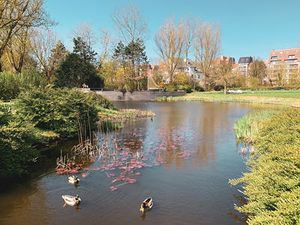




![Middelkerke Town Hall in Spermaliestraat 1. Protected building since June of 2002 in the Middelkerke Submunicipality. The eclectic Town Hall was built in 1924-1925 and is designed by architect G. Van Damme. [1]](/images/thumb/c/c9/Middelkerke_town_hall.png/195px-Middelkerke_town_hall.png)
![The Coast Tram, the longest tram line in the world, is a public transport service between Knokke and De Panne [2]. In Middelkerke there are two architectural heritage buildings in Leopldlaan street honoring the original tramline- the Tram booth [3] and Traction station. The Traction station (on the picture) is built in the early 1920s and is designed by architect Georges Vivenoy. On the facade, there can be seen an art deco impact. Traction station has been protected as a monument since October of 1995.[4]](/images/thumb/2/25/Traction_station.png/200px-Traction_station.png)
![Art Nouveau style chapel of Saint Theresa is a protected building since June of 2002. The modernist north-south oriented chapel was founded in 1932-1933 and is designed by architect AV Flaubert. In the interior, there are numerous neoclassical elements, frescos and stained glass windows making the chapel an important sight to see. [5][6]](/images/thumb/c/c5/Saint_Theresa_Chapel.png/200px-Saint_Theresa_Chapel.png)
![Middelkerke is rich by its architectural heritage. There are numerous protected buildings in the style of art deco and eclectic, built in the 1920s. On the picture is an example of eclectic Hotel Continental on the Joseph Casselaan 3, Zeedijk 59. It is situated in the promenade and has a view to the sea from Zeedijk street [7]. Few of them are the style of neo-gothic and neo-Rococo, which are built around 1889-1899. [8]](/images/thumb/3/37/Architecture.png/84px-Architecture.png)

![The Warandeduinen nature park is a certified nature reserve since 2003. The area size is 33 hectares big. [9]. This is a calcareous dune belt with a large and varied natural richness between Westende-Bad and Middelkerke. The area is rich by the growth of orchids [10]. Watch more photos in link: [11].](/images/thumb/b/b8/De_warandeduinen.jpg/200px-De_warandeduinen.jpg)
![The Puidebroeken (in English: Puffy Trousers) is a 14.5 hectares big nature reserve near Middelkerke. It is a protected area since 2003. [12]. The area contains mainly artificial grounds from World War I when it was used to excavate clay for the production of brick. For now it a wet meadow that has a bad water runoff. There are living numerous meadow birds, frogs, insects, and plants. The area is not freely accessible. [13]](/images/thumb/2/2a/Puffy_trousers.jpg/200px-Puffy_trousers.jpg)
![Raversyde Nature Park is a large landscape of water, reed fields, grasslands, meadows, plantations, and forests. It is situated in Ostend but is close to our case study Middelkerke. [14]](/images/thumb/f/fb/Raversyde_nature_park.jpg/200px-Raversyde_nature_park.jpg)
![Comic art in Middelkerke [15]](/images/thumb/0/09/Statues_of_cartoon_characters.jpg/169px-Statues_of_cartoon_characters.jpg)
![I can hear it by Ivars Drulle. Beaufort gems in Middelkerke.[16]](/images/thumb/2/25/I_can_hear_it.jpg/200px-I_can_hear_it.jpg)
